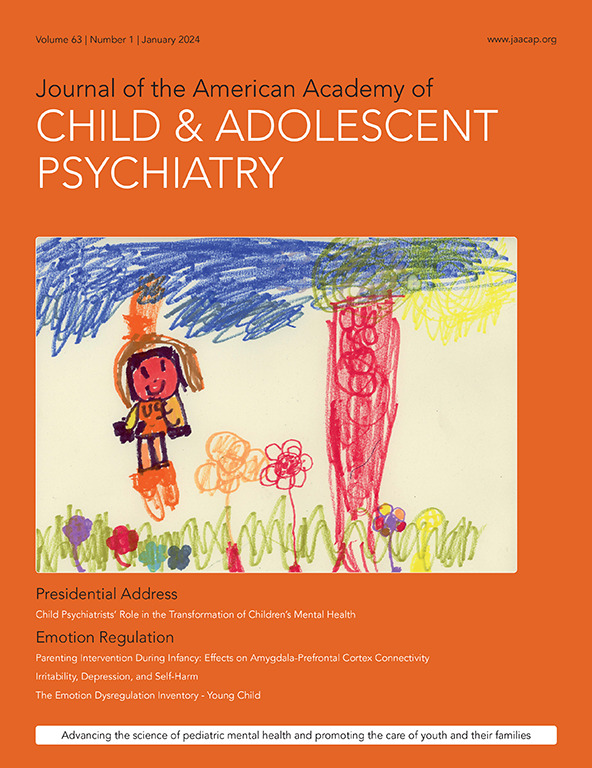A Systematic Review and Meta-Analysis: Child and Adolescent Healthcare Utilization for Eating Disorders During the COVID-19 Pandemic
IF 9.2
1区 医学
Q1 PEDIATRICS
Journal of the American Academy of Child and Adolescent Psychiatry
Pub Date : 2025-02-01
DOI:10.1016/j.jaac.2024.02.009
引用次数: 0
Abstract
Objective
To conduct a meta-analysis documenting healthcare service utilization rates for pediatric (age <19 years) eating disorders during compared to before the COVID-19 pandemic.
Method
PsycINFO, MEDLINE, Embase, and Web of Science Core Collection were searched for studies published up to May 19, 2023. Studies with pediatric visits to primary care, inpatient, outpatient, and emergency department for eating disorders before and during the pandemic were included. This preregistered review (PROSPERO CRD42023413392) was reported using PRISMA guidelines. Data were analyzed with random-effects meta-analyses.
Results
A total of 52 studies reporting >148,000 child and adolescent eating disorder–related visits to >300 health settings across 15 countries were included (mean age, 12.7 years; SD = 4.1 years; 87% girls). There was strong evidence of an increase in healthcare use for eating disorders during the pandemic (rate ratio [RR] = 1.54, 95% CI = 1.38-1.71). Moderator analysis revealed larger rate increases among girls (RR = 1.48, 95% CI = 1.28-1.71) compared to boys (RR = 1.24, 95% CI = 1.06-1.45) and for adolescents (age ≥12 to 19 years) (RR = 1.53, 95% CI = 1.29-1.81) compared to children (RR = 0.87, 95% CI = 0.53-1.43). Moderator analysis demonstrated strong evidence of increased use of emergency department (RR = 1.70, 95% CI = 1.48-1.97), inpatient (RR = 1.56, 95% CI = 1.33-1.84), and outpatient (RR = 1.62, 95% CI = 1.35-1.95) services, as well as strong evidence of increased rates of anorexia nervosa (RR = 1.48, 95% CI = 1.24-1.75).
Conclusion
Healthcare use for pediatric eating disorders increased substantially during the COVID-19 pandemic, particularly among girls and adolescents. It is important to continue to monitor whether changes in healthcare use associated with acute pediatric mental distress are sustained beyond the COVID-19 pandemic.
Plain language summary
In this study, the authors analyzed data from 52 studies from 15 countries and found a significant increase in healthcare utilization for eating disorders during the COVID-19 pandemic. The study findings suggest a larger rate increase among adolescents as compared to children, in girls versus boys, and for anorexia nervosa in particular. Results also indicate increased use of emergency department, inpatient and outpatient services for eating disorders during the pandemic.
Study preregistration information
Risk factors for eating disorders for youth during the COVID-19 pandemic; https://www.crd.york.ac.uk/; CRD42023413392.
Diversity & Inclusion Statement
One or more of the authors of this paper self-identifies as a member of one or more historically underrepresented racial and/or ethnic groups in science. One or more of the authors of this paper self-identifies as living with a disability. We actively worked to promote sex and gender balance in our author group. We actively worked to promote inclusion of historically underrepresented racial and/or ethnic groups in science in our author group. While citing references scientifically relevant for this work, we also actively worked to promote sex and gender balance in our reference list. While citing references scientifically relevant for this work, we also actively worked to promote inclusion of historically underrepresented racial and/or ethnic groups in science in our reference list. The author list of this paper includes contributors from the location and/or community where the research was conducted who participated in the data collection, design, analysis, and/or interpretation of the work. One or more of the authors of this paper self-identifies as a member of one or more historically underrepresented sexual and/or gender groups in science.
系统回顾与元分析:COVID-19大流行期间儿童和青少年因饮食失调而就医的情况。
目标对儿科医疗服务利用率进行荟萃分析:搜索 PsycINFO、MEDLINE、Embase 和 Web of Science Core Collection 中截至 2023 年 5 月 19 日发表的研究。纳入了大流行前和大流行期间儿科初级保健、住院、门诊和急诊科就诊情况的研究。该预先注册的综述(PROSPERO CRD42023413392)采用 PRISMA 指南进行报告。数据采用随机效应荟萃分析法进行分析:共纳入了 52 项研究,这些研究在 15 个国家的 300 多个医疗机构中报告了超过 148,000 次与儿童和青少年饮食失调相关的就诊(平均年龄为 12.7 [SD 4.1] 岁;87% 为女孩)。有确凿证据表明,大流行期间就诊于饮食失调症的人数有所增加(比率比 [RR] 1.54,95%CI 1.38-1.71)。主持人分析显示,与男孩(RR 1.24,95%CI 1.06-1.45)和青少年(≥12 至 19 岁)(RR 1.53,95%CI 1.29-1.81)(RR 0.87,95%CI 0.53-1.43)相比,女孩(RR 1.48,95%CI 1.28-1.71)和青少年(≥12 至 19 岁)(RR 1.53,95%CI 1.29-1.81)的比率增幅更大。主持人分析显示,有确凿证据表明急诊科(RR 1.70,95%CI 1.48-1.97)、住院(RR 1.56,95%CI 1.33-1.84)和门诊服务(RR 1.62,95%CI 1.35-1.95)的使用率增加,也有确凿证据表明神经性厌食症(RR 1.48,95%CI 1.24-1.75)的使用率增加:结论:在 COVID-19 大流行期间,儿科急诊室的医疗使用率大幅上升,尤其是女孩和青少年。在 COVID-19 大流行之后,继续监测与急性儿科精神痛苦相关的医疗利用率是否会持续发生变化非常重要。
本文章由计算机程序翻译,如有差异,请以英文原文为准。
求助全文
约1分钟内获得全文
求助全文
来源期刊
CiteScore
21.00
自引率
1.50%
发文量
1383
审稿时长
53 days
期刊介绍:
The Journal of the American Academy of Child & Adolescent Psychiatry (JAACAP) is dedicated to advancing the field of child and adolescent psychiatry through the publication of original research and papers of theoretical, scientific, and clinical significance. Our primary focus is on the mental health of children, adolescents, and families.
We welcome unpublished manuscripts that explore various perspectives, ranging from genetic, epidemiological, neurobiological, and psychopathological research, to cognitive, behavioral, psychodynamic, and other psychotherapeutic investigations. We also encourage submissions that delve into parent-child, interpersonal, and family research, as well as clinical and empirical studies conducted in inpatient, outpatient, consultation-liaison, and school-based settings.
In addition to publishing research, we aim to promote the well-being of children and families by featuring scholarly papers on topics such as health policy, legislation, advocacy, culture, society, and service provision in relation to mental health.
At JAACAP, we strive to foster collaboration and dialogue among researchers, clinicians, and policy-makers in order to enhance our understanding and approach to child and adolescent mental health.

 求助内容:
求助内容: 应助结果提醒方式:
应助结果提醒方式:


